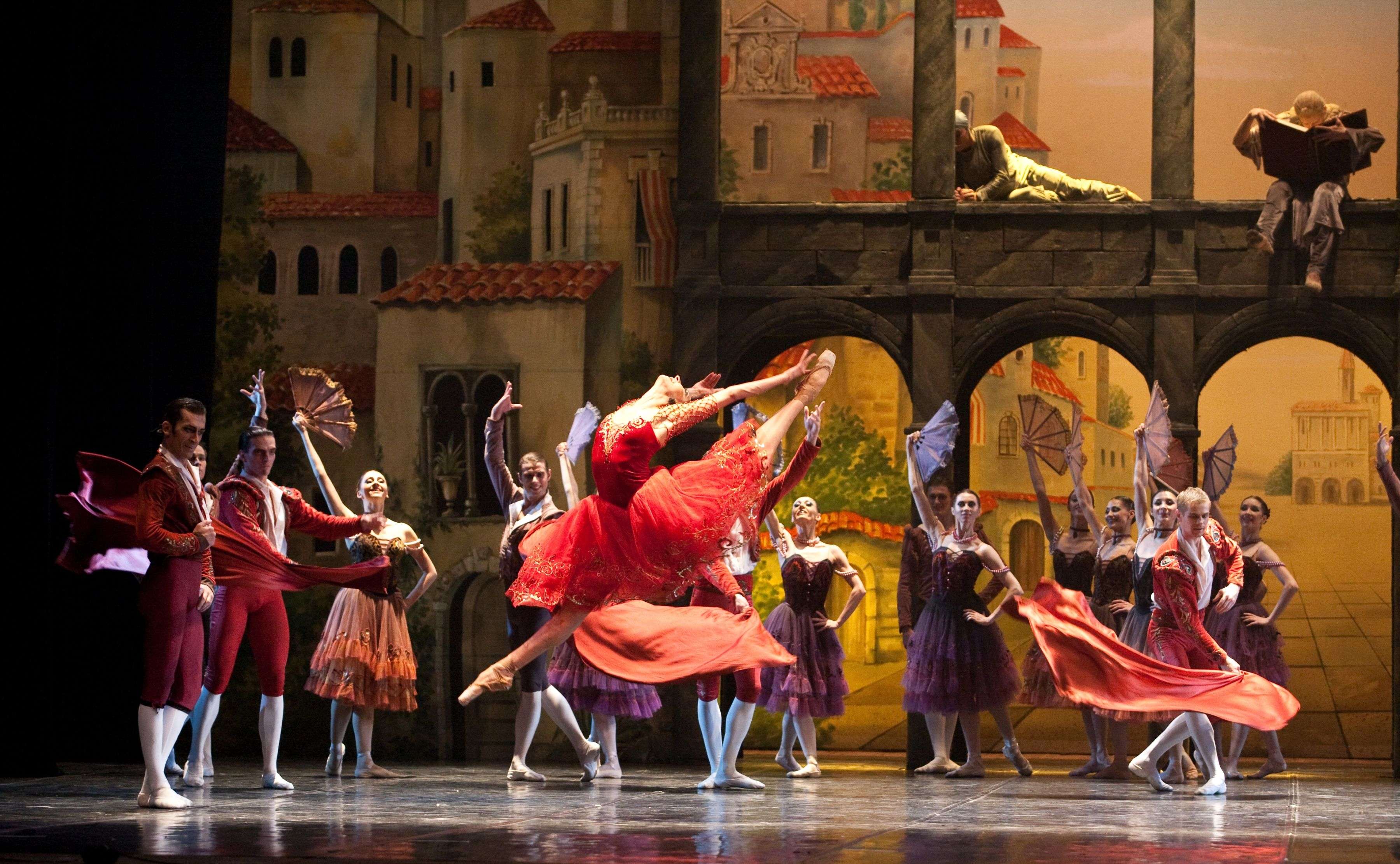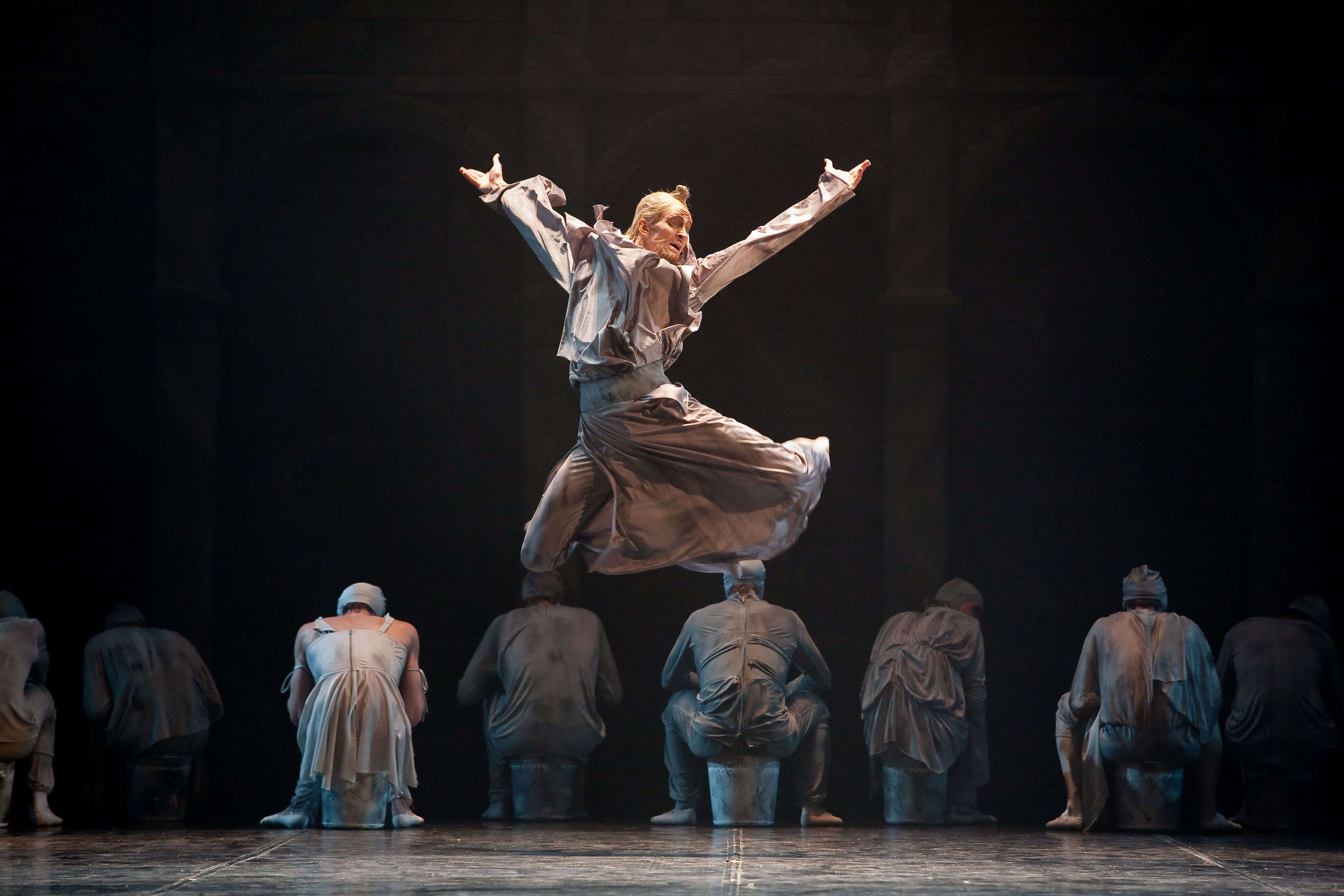|
Back
A New Take on Traditional Ballet Orange County
Segerstrom Hall
04/26/2011 - & 29, 30 and 1 May 2011
Ludwig Minkus: Don Quixote
Eifman Ballet of St. Petersburg, Boris Eifman (Artistic Director), Yulia Manzheles*/Anastasia Sitnikova (Doctor in a Madhouse), Sergey Volobuev*/Oleg Gabyshev (Don Quixote), Nina Zmievets*/Natalia Matsak (Kitrí), Anastasia Sitnikova*/Yulia Golitsyna (Dulcinea), Oleg Gabyshev*/Mikolai Radzuish/Ivan Zaytsev (Basil), Alexander Melkaev*/Anatoly Grudzinsky (Sancho Panza), Igor Poliakov*/Alexander Ivanov (Lorenzo), Dmitry Fisher*/Vladimir Dorokhin (Gamache)
Boris Eifman (Choreography), Vyacheslav Okunev (Scenery and Costume Designer)

(© Hana Kudryasheva)
Miguel Cervantes’ novel profiling the lanky chivalrous Don Quixote is epic indeed, but when it comes to artful composition, Ludwig Minkus excerpted a sliver of the two volume work to translate into ballet music, paired with choreography by the esteemed Marius Petipa. Don Quixote, a global favorite since its opening on December 14, 1869, however, is not without its continued revisions which exist to this day.
Choreographer Boris Eifman challenges this treasured classic with an innovative twist. Growing up in a sullen Russia of the 1970s may give us better perspective into his own “artistic revolution”: resetting Don Quixote in an insane asylum. Why resort to a seemingly quixotic cell of loonies, you ask? From the traditionalist’s point-of-view Don Quixote is a couple hours worth of snappy dancing and comedic entertainment, but through the eyes of Boris Eifman there’s a cerebral, weighted calculation. Underneath that veil of superficiality is a focus to impart a deep seated message with attenuated gravitas: reality retains harshness and evil, but within the mentally insane, one see’s a respite of hope, love and beauty. By assigning the title role with the description of the “Patient imagined himself being Don Quixote” we find Eifman’s slightly deranged knight-errant as an exemplar to the secular world to live a more respectful, courteous life. We all can take a lesson from the book of Eifman.
Eifman Ballet can be described as the Cirque de Soleil© of ballet. Perhaps controversial to the purists, it is, nonetheless, innovative, fluid and connected. All principal dancers excel within their own domain. This Don Quixote, compactly contained in two acts, loosely follows ballet’s more traditional synopsis. Set against pre-recorded music (no credit is given to the orchestral group) the tempo is fast paced, audibly pleasing and vibrantly accentuated. The dancing never lags, and no one remains in one place for more than a pocketful of seconds. Eifman “cuts and pastes” Minkus’ score in order to brilliantly fit into own his storyline while turning conventionality upside down by mixing up gender and dancers for different numbers (i.e. Minkus’ original “Overture” begins early in Eifman’s Act II; “Amour” moves from Act III to Eifman’s Act I, danced by a man not a woman.)

(© Hana Kudryasheva)
Donning an institutional full length white uniform is the lithe Yulia Manzheles, interpreting the Doctor in a Madhouse with a cold and penetrating streak; she plays her part well, and she is equally impressive when executing her arabesque penchée alongside Don Quixote. Sergey Volobuev is an active Don Quixote in conjunction with Alexander Melkaev’s antics as the self perceived Sancho Panza. Kitrí, performed by Kiev-born Nina Zmievets, is agile and exuberant, particularly the fouetté en tournant; the only clear cut remnant in the Petipa tradition occurs in the “Kitrí Variation” (found at the end of Minkus’ first act.) In Act II we find Anastasia Sitnikova dressed in a black and red dress who seductively portrays an alluring Dulcinea.
Equally outstanding is Oleg Gabyshev as Basil who exceeds with flair during his grand pas variation. Meanwhile, Dimitry Fisher dancing the role of Gamache, and Igor Poliakov as Kitrí’s father, Lorenzo, serve up the right amount of charm thanks to Eifman choreography.
Vyacheslav Okunev’s two tiered Roman arches anchor the set in combination with the alternating colorful backdrop of the Barcelona dream and the austere and vacuumed madhouse. Nowhere do we see the use of castanets, but their percussive sounds can be heard in the background audio. The cellmates’ pantomime-like maneuvers are interpretively coherent while an easily recognizable Catalonian pastiche fills the stage during the reverie sequences.
This Don Quixote may wreak havoc with the traditionalist party, yet Eifman Ballet of St. Petersburg deserves a warm round of applause for the devotion and commitment to their profession. Summing up the evening’s experience: calibrated excellence.
Christie Grimstad
|